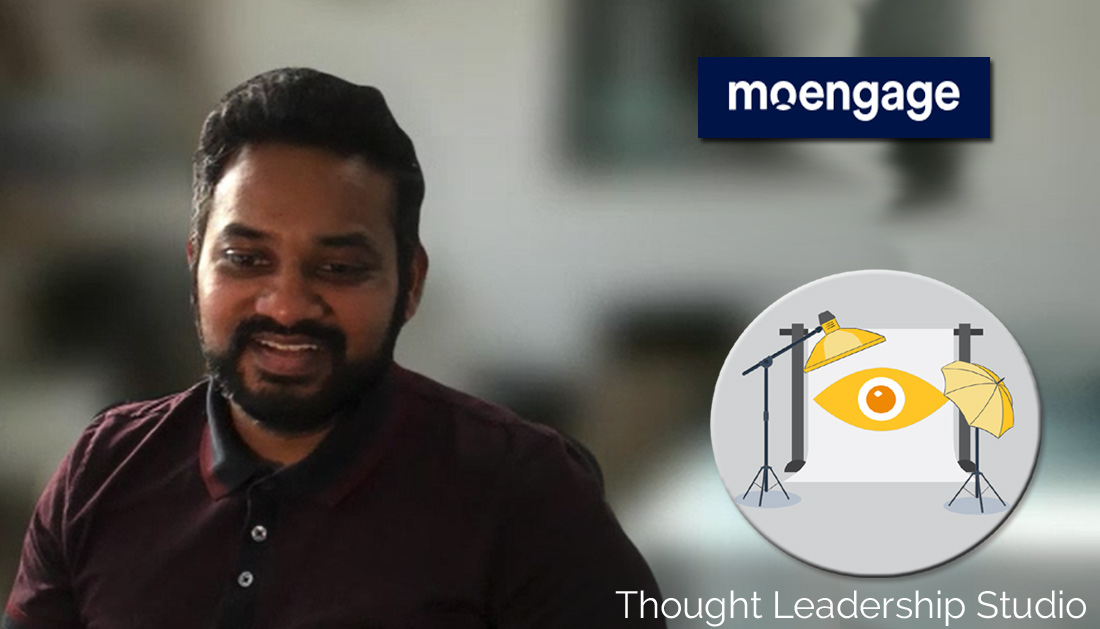Thought Leadership Studio Podcast Episodes:
Strategic Insights in Marketing Innovation with Aditya Vempaty of MoEngage
Episode 67 - Crafting the Future of Engagement: Insights on Leveraging AI for Deep Personalization in Marketing Strategies

#ai, #artificialintelligence, #communication, #interviews, #marketing, #marketingstrategy, #marketlistening
Or Click here to listen or subscribe on appWhat this episode will do for you
:- Engagement Through Personalization: Learn the significance of meeting customers where they are with Aditya's insights as well as strategies for crafting messages that resonate on a personal level.
- Innovation in Customer Interactions: Explore innovative approaches to engage customers and build lasting relationships.
- Humor Meets Innovation: Explore the journey from humor to innovation in marketing, sparking both 'Haha' and 'Aha' moments among audiences.
- Understanding and Engaging: Delve into the art of truly meeting customers where they are, ensuring every message deeply resonates.
- Marketing's New Era: Witness the transformation of traditional marketing beliefs into dynamic, personalized strategies powered by AI.
Aditya Vempaty.
In this episode, I interview Aditya Vempaty, the North America Marketing lead at MoEngage. We discuss the significance of personalized customer engagement and digital marketing.
He highlights the challenges marketers face, such as data overload and the necessity for integrated marketing tools. We also discuss the transformative power of humor and innovation in marketing, moving from 'Haha' to 'Aha' moments to captivate audiences. We delve into the art of understanding and engaging customers by meeting them where they are, ensuring messages resonate personally and contextually.
Aditya also discusses the shift from traditional marketing beliefs towards a landscape where personalization and relevance reign supreme. Aditya's insights spotlight the journey towards creating more meaningful, customer-centric experiences in the digital age.
Some of Aditya's coordinates:
Curated Transcript of Interview with Aditya Vempaty
The following partial transcript is lightly edited for clarity - the full interview is on audio. Click here to listen.
Chris McNeil: I'm Chris McNeil, with Thought Leadership Studio, and I'm sitting across Zoom with Aditya Vempaty who leads North America Marketing at MoEngage.
He's a problem focused marketing executive category creator with an engineering background. He's built and scaled marketing teams for software as a service, life sciences and enterprise infrastructure companies prioritizing customer problems. This past teams have achieved a 400% revenue growth in 16 months in Amplitude leading to a successful IPO.
Similarly at Nutanix, they created a category and built a marketing and sales team that focused on solving customers pressing problems, resulting in a 4.5 billion (with a B) IPO. Aditya's data-driven approach to marketing and focus on customer needs, have driven sustainable sales pipelines on the global scale, and don't we all want to have sustainable sales pipelines on a global scale. Welcome.
 Aditya Vempaty: Thank you for having me on the show, Chris. I'm really excited to chat, hopefully share whatever knowledge I can and give value to your listeners.
Aditya Vempaty: Thank you for having me on the show, Chris. I'm really excited to chat, hopefully share whatever knowledge I can and give value to your listeners.
Chris McNeil: Looking forward to it. So what sets you on this path of marketing technology, of building these types of sustainable sales pipelines on a global scale?
From Engineering to the Satisfaction of Positive Influence
Aditya Vempaty: Yeah, I think it went back to how I like to say I'm a failed engineer who fell in love with marketing and the reason is as engineering ... sitting there, writing lines of code is great. You can impact a lot of people. I just missed that human interaction and I realized I really enjoy working with people in person or using words or engaging them at a psychological level where I am ensuring I build trust and deliver value to them so that they recognize the problems they're having and hopefully choose the products that I represent as their solutions, as solutions for them.
But it was mainly about being able to engage and get audiences to psychologically buy into what I was marketing to them or presenting to them.
Chris McNeil: So you get satisfaction from influence?
 Aditya Vempaty: Yeah, I definitely do. I do get satisfaction from influencing people in a positive way, obviously in ways that solve their problems, not in ways that make them buy things that may not be necessary to their life.
Aditya Vempaty: Yeah, I definitely do. I do get satisfaction from influencing people in a positive way, obviously in ways that solve their problems, not in ways that make them buy things that may not be necessary to their life.
Chris McNeil: Well, it's all about serving people and if you create an environment where people can better learn what their needs are and how what you have to offer can help them, you can help them elevate their lives in many ways, obviously. So you switched from engineering to marketing, but you still have but the engineering background that informs what you do?
Aditya Vempaty: Yeah, it actually does quite a bit. That's a great question. I think in the last about 10 to 15 years, marketing has gone a radical shift. It's gone from not being data-driven to being too data-driven, and I think we've sung too far and too fast to the other direction. And so everything now has become in the engineering world, where's the data? What does it tell me, dig into the data, should we continue doing this? Should we not continue doing this?
And that's where it's helped me make decisions. But where I think engineering has fun fact hurt, I think I would say most marketers is that we've lost creativity in marketing and said, does the data do it or not do it? And focused on that more than like, 'Hey, you have to be creative and look at what's going on in the market'. Look at how much noise there is and how do you stand out through that noise? What are creative things you can do that the data doesn't show you?
And the engineering side has helped me, I would say be very data-driven, but then the creative side is pull that back to be like, Hey, we got to try some things here because the data is a lagging indicator of what will work and not a leading indicator of what to do.
Chris McNeil: That's an excellent point. I think that plays right into my whole schtick with Strategic Thought Leadership and it's about leading people to new creative solutions, new creative ideas and so forth, as opposed to studying what people did in the past to predict what they're going to do in the future, not that there isn't some value in that.
But what do you think about using data from the customer's point of view to help them to better listen to customers and learn what their maybe unmet values and needs are that they may have trouble articulating, but the right type of listening could discover?
Aditya Vempaty: You hit the nail on the head. This is actually how I deeply, deeply love marketing and care about marketing is because of this. I love talking to prospects, surveying prospects to understand what their real problems are. Not what you hear, oh, I bought the solution for X, Y, Z. I think people tell you only what you want, you want to hear, but when you survey them and survey larger groups, you start seeing trends, you start understanding what the core problem is, what's the business problem they're trying to address?
And the biggest thing is how do you talk to customers and hear their pain point and not focus on the solution? Oftentimes for me it's about being creative and being like, Hey, don't worry about the solution. Don't worry about what you want to buy or you want to solve it. Tell me how this problem is hurting you. Tell me how it's making your life worse. Tell me how it's impacting your business. Forget about solving it.
Humor and Innovation: From Haha to Aha
Really asking how their life would be if they could solve it versus what would they use to solve it. And getting into the nuts and bolts of it and then understanding this is all my favorite thing to do is understanding all the vocab and the terms and then all the jokes that these people have in these industries and really bringing that to light. At my previous company we did a shirt that said, I don't catch feelings, I catch fraud.
 And we service people who are fighting fraud and people love that. They're like, oh my God, this is great. It's understanding their pain and making a joke of it and being creative so they engage with you. And as you said earlier, it's not about data doesn't tell you where to go, but it does tell you what's happened and you can use that and formulate where to go next from a creative aspect. And they're like even at MoEngage, we're putting a report together or we've surveyed over 1200 people and put a report analyzing 760 of them about what their pain points are on cross channel marketing. And we partnered with the market opportunist to make the report and had him do drawings about the pain points.
And we service people who are fighting fraud and people love that. They're like, oh my God, this is great. It's understanding their pain and making a joke of it and being creative so they engage with you. And as you said earlier, it's not about data doesn't tell you where to go, but it does tell you what's happened and you can use that and formulate where to go next from a creative aspect. And they're like even at MoEngage, we're putting a report together or we've surveyed over 1200 people and put a report analyzing 760 of them about what their pain points are on cross channel marketing. And we partnered with the market opportunist to make the report and had him do drawings about the pain points.
And those drawings are funny and they engage the audience and make them laugh at their own problems in a way where you're like, oh, I remember, that's great. That brand understands me and formulating that connection.
Chris McNeil: That's awesome. I'm getting a couple cool threads to pick up on here that I kind of want to draw out for our audience, if you don't mind. One of them is I love the humor aspect and someone said "Aha is very close to Haha" - and that the paradigm shift is the essence of humor and also the essence of innovation.
Being able to see things from a new perspective. I mean a good joke shifts your perspective and that's the punchline.
Aditya Vempaty: You nailed it.
Chris McNeil: And innovation does the same thing. So keeping people in a learning state if you want to have a creative team for instance, means keeping things light so that they're open to new ideas with that, looking for what could be different from how we normally look at things. And this whole paradigm that you're working with, with engage with cross channel marketing is of course fascinating.
Anybody who wants to have large scale influence, who wants to make a difference and wants to lead audience somewhere new is going to be doing it through media these days. They're not going town to town shaking hands, knocking on doors like politicians in the 18 hundreds maybe to some extent. It's nice when we can have these conferences where people actually meet in person, but it's typically done over media. And my understanding is what you're doing with Moen Engage is trying to make that more of a seamless, low friction process for a customer or say your meta clients, your client's clients to engage with your clients.
What are some things you think might be interesting to our audience of thought leaders, entrepreneurs, marketers, innovators, in thinking about what you've learned through bringing that to life and expanding it as the VP of North America for MoEngage?
Understanding and Engaging: The Art of Meeting Customers Where They Are
Aditya Vempaty: Yeah, I think the biggest thing is the problems. Anyone who's listening to this that has a company or leading an organization can't stress enough about understanding your prospects and more than just understanding your prospects, meeting them where they are with Engage, what we really are trying to do with our product is enable our customers, our brands, to meet their customers where they are on their journey.
 If a customer is interacting with the brand and they only making a purchase off a website, but they open an email and scroll and then go to the website to make a purchase and not in the app, we want to make sure to surface those insights for the brand. So the brands are like, oh, this is how I got to operate, this is how this person makes that purchase. And then at the same vein, there're going to be another person who only makes purchases in an app and doesn't look at email and only does responds if you do a notification for the app.
If a customer is interacting with the brand and they only making a purchase off a website, but they open an email and scroll and then go to the website to make a purchase and not in the app, we want to make sure to surface those insights for the brand. So the brands are like, oh, this is how I got to operate, this is how this person makes that purchase. And then at the same vein, there're going to be another person who only makes purchases in an app and doesn't look at email and only does responds if you do a notification for the app.
And really how do brands service both of these because these are both different types of purchasing patterns from the same product that they want to buy. And so among age, we want to enable brands to service audiences in their pattern of their customer journey and how they make purchases and how they interact with the brand. And that requires different level levers to pull on different channels and different messaging, but brands need to know that they need to know how these purchases are happening or not and what it takes so they can contextually make sure they're delivering value to their customers and not just sending emails to someone who's like, I'm never opening an email, but if you send it to me and you realize in an app that I'll make a purchase.
Knowing that and knowing that the customer gets the value of, okay, I should send an in-app push. I don't need to send them an email for them to get value from me and vice versa. Another person who only purchases through email and the website versus never opens the app and allowing them to have these insights and use these insights and accordingly deliver value to their audiences.
Chris McNeil: Isn't it fascinating how intricate marketing has gotten where you have this psychological layer of positive persuasion of empowering people to make smarter purchase decisions or get more value out of a product or service and all the content marketing that we do to help them do that and to build a relationship by empowering our audience, but then you have the technology layer of are the right channels matching up with how our customers really behave when they interact with our message and grow closer to us and then interact with our products and services ... and with our people on the way to getting those products and services.
Aditya Vempaty: Exactly like that - understanding the intricate layer, putting in that angle of positivity, and knowing when to use it and deliver the product and services that people want. You're talking about the magic bullet. You're talking about understanding the customer journey, understanding where the gaps are and how you can bridge them together. And that's what we really want to do at MoEngage is tie that together for people on whatever scale, large or small, whatever frequency as well.
The Transformation of Traditional Marketing Beliefs
Chris McNeil: What are some outdated belief systems that you found that are prevalent in customers and business people in general that have inhibited them from making the best use of technology and getting their message to the customer and connecting with their customers that could use an overhaul? If you had to overhaul four or five prevalent belief systems that are still out of date that need to be brought up to date, what would those be?
Aditya Vempaty: There's three, I would say. I don't know if there's four or five, but there's three deep convictions I think I have, right? And they start from this quote that I read and it stuck with me so well again, storytelling and emotional connections here. Aha to haha. It was this quote that said don't sell people quarter inch drills, sell them quarter inch holes. And that stuck with me because it identifies three key things that are still broken today, even in the new, as you said, media digital age.
 One is people are very focused on their products. They're still trying to sell people a quarter inch drill and talking about how the drill is amazing, it doesn't break, it's made from X, Y, Z. Then the next is that they're actually trying to sell people. You're really just trying to see there and say not just the product, but you're constantly trying to get them to buy.
One is people are very focused on their products. They're still trying to sell people a quarter inch drill and talking about how the drill is amazing, it doesn't break, it's made from X, Y, Z. Then the next is that they're actually trying to sell people. You're really just trying to see there and say not just the product, but you're constantly trying to get them to buy.
People will buy when they want to buy. They're not going to buy on your timeline, they're going to buy on your terms. And so that's the second part. Stop trying to sell somebody, right? And the first part is stop trying to sell. Stop trying to talk about your product, stop trying to sell them. And the third one is you need to focus on the problem. And that has not shifted. People still talk about the company, they focus on what the company can do, they focus on getting you to buy something and they focus on getting you to buy a specific product.
And so a lot of the marketing still is, I am X company, this is what I do for you and this is what you should buy from me instead of, Hey, this is a problem that you have. This is how that problem is impacting you and this is how it's affecting your life. Let me give you insights into how the world could be if this problem was solved regardless of you purchasing from me or not. And that quote I think summarizes it so well. Like I said, don't sell a quarter inch drill, sell a quarter inch. Tell them how they can drill a quarter inch hole.
Chris McNeil: Well, we start these companies and we invest our hearts in them and we get emotionally attached to them and we forget we need to quit falling in love with our products and services and fall in love with our customers and prospects instead.
Aditya Vempaty: And it's not easy though, right? Because when you build a company or you build a product, whether you take funding or you get customers, it's balancing acts of, Hey, I know what I'm doing to, oh crap, maybe I don't know what I'm doing. I need listen to the customer. And what I noticed with entrepreneurs, you have to have a conviction to move forward, but you also have to have the humility to have conversations that may not be comfortable and it's not easy.
And that's where I think we have to break that mold and be Okay, our baby's not ugly, we just need to put them in different clothes. And people don't like hearing your baby's ugly, baby's not ugly, it's just the clothes aren't working on the baby, so let's figure out how to make the baby look good.
Chris McNeil: Yeah, some people call it designing from the outside-in: that deep empathy of being able to really step into your prospect and customer and see things through their eyes and then feel what they're feeling and look out from that point of view and design your product and service through them.
But it is hard sometimes to see our organizations through the tinted glasses of our customers and prospects more limited understanding of what we do. And I imagine that's really challenging with such a technical product as you represent, how do you break down those barriers and get on the customer side when you're dealing with highly technical things you need to describe and get them to adapt to?
Aditya Vempaty: And so dealing with those barriers, oftentimes what I see is people really get into the features and they really get into the nitty gritty and be like, this is how this works. This is how this can be done and this is what it does for you. But most people find and formulate connections with stories, with emotion. And so I always try to make sure we go back to what is the deep emotional connection that they have with a problem and really be like, Hey, this is the problem. How's it hurting you? And this is how it could be solved and this is how we solve it.
And really form that deep emotional connection with the problem and not the feature, but with the problem and how it resonates with us and with a potential solution. And that's what we really start before going into the technical features and speeds and feeds and abilities. And that's what we try to do. And we're going through a bit of a shift here, but that's what we want to end up at. It's going to take a little bit of time, but that's the goal.
***************************************
The transcript is lightly edited for clarity and is a partial transcript- the full interview is on audio. Click here to listen.
***************************************
Free Stuff and Offers Mentioned in Podcast
***************************************
X
***************************************